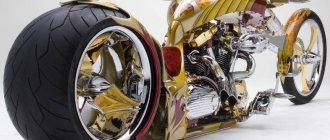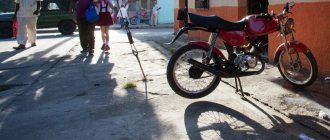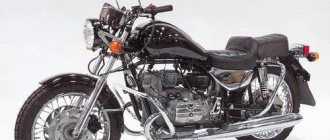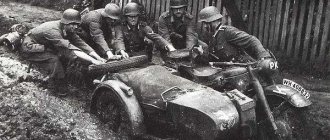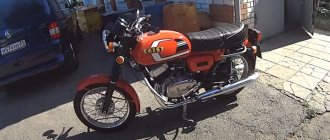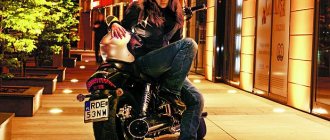The production of motorcycles in Germany began in pre-war times. After the peace treaty was signed, the Germans were prohibited from producing various types of weapons, but motor vehicles were not included in this list. This marked the dawn of the motorcycle industry in Germany. At that time, a car was considered a luxury item, but anyone could buy a regular moped. Companies such as BMW and Zundapp took an active part in the creation of two-wheeled units.
At first, the boxer engine did not stand out in any way against the background of foreign units. However, already in 24, the company independently assembled the first production bike, the BMW R32 . True, the time of motorcycles for general use quickly exhausted its need, and already in the 30s the concern began to produce military motorcycles. The first vehicle specialized in military needs was the BMW R35. This was the first German military motorcycle of the Bavarian company, which had a telescopic fork in front and a 398 cc engine. Low wear and tear during use made this bike indispensable for military purposes. Production lasted about 10 years, after which it gave way to narrow specialization.
In addition to the 35th model, there was also a 12th model. It was an improved version with a larger 750 cc engine. and hydraulic suspension. Removing one carburetor reduced power by 2 horsepower. In 1935, 35 thousand of these units rolled off the assembly line. Low cost and good performance ensured the popularity of this model. In addition, the ability to install the stroller satisfied the needs of many owners. In addition to standard modifications, springs were installed to transport people wounded in battle.
Then the 71st model , which became the basis for the creation of the Soviet Ural and Dnepr motorcycles. The production began in 1938 and was active for a couple of years, after which the unjustification of costs forced the owners to close the project. The equally popular company Zundapp created cheaper bikes with sidecars. Due to their price and maneuverability, they became the basis of the German army's weapons. The most popular model, the K800, was the only model with a four-cylinder engine. This system was rather problematic because it did not provide sufficient cooling to the last two cylinders. This made using the bike for a long time impossible, in addition, the spark plugs often became oily and jammed during operation.
The Great Patriotic War and military motorcycles
German motorcycles of the Second World War consisted of only two models - the BMW R75 and the Zundapp KS750. They performed well off-road and produced good power. Both units had all-wheel drive; we put strollers on the wheel. But the cost of these models did not allow the use of the equipment in Germany. Therefore, all produced equipment was sent from the assembly line to foreign buildings. This continued from 1940 to 1942. Then the decision came to release a modified version of the KS750 with a trailer from BMW . True, the model was never produced in mass production, since the previous order from the state for 40,000 copies of models with a sidecar was not fully completed, stopping at the production of approximately 17,000 mopeds.
Throughout the war, the Germans produced a motorcycle with caterpillar tracks. Such an innovation was surprising not only for opponents, but also for Germany itself. The model was called Kettenkrad and was produced for five years, during which about 8.5 thousand such devices were created. Due to the installed tracks, the bike's cross-country ability in the most difficult conditions was significantly increased. True, when turning, the equipment often turned over, while the driver did not have time to jump due to the difficulties of landing. Moreover, the significant weight of the unit did not allow it to climb the slopes in a diagonal trajectory.
Like all German motorcycles of the Second World War, the Kettenkrad had a large engine with a volume of one and a half liters. True, in appearance such a device was more reminiscent of a small infantry fighting vehicle than a motorcycle. It was convenient to transport people. I was also pleased with the ease of control, albeit with minor shortcomings, but for a bike with such dimensions the idea was very good. The Wehrmacht tracked motorcycle, with all the abundance of iron cover, weighed quite a bit - only 325 kilograms. For a 1.4-liter engine that produced 26 horsepower, such a mass did not cause any particular problems.
German units made a great impression not only on Soviet manufacturers. After the war, many foreign analogues of the BMW R71 model were created. For example, Harley borrowed BMW's four-speed gearbox and driveshaft drive to the rear of the motorcycle.
The most unusual combat motorcycles in history
Self-propelled two-wheeled vehicles appeared back in the 60s of the 19th century; initially, a steam engine was installed on them.
These were the most distant ancestors of modern motorcycles. The first motorcycle with an internal combustion engine was built by German engineers Wilhelm Maybach and Gottlieb Daimler in 1885. Both engineers are the founding fathers of two major automobile brands that are still known throughout the world today. Gradually, motorcycles developed, improved, and by the beginning of the First World War they reached a level that attracted the attention of the military of many countries. It is worth noting that before the start of the First World War, the horse remained the main means of transportation in all armies. Horses were used in armies in huge numbers, but they required daily care, they had to be fed and watered. For example, in the Russian Imperial Army in 1916, 50 percent of all food cargo was horse feed: oats, hay, feed straw. These were millions of pounds of cargo, which were not only heavy, but also took up a lot of space. The advent of mechanized vehicles greatly simplified logistics, and they could not be treated like a living creature.
Motorcycles were especially popular with infantry, signalmen and messengers. During the First World War, motorcycles underwent a baptism of fire and began to be used quite massively. They were used for courier communications, terrain reconnaissance, as a means of quickly transporting small loads, and in some cases as combat vehicles. Over time, weapons, small armor and camouflage paint began to appear on motorcycles. By the beginning of World War II, motorcycles were already widely used by all armies of the world, and the image of a German soldier on a motorcycle with a sidecar became a textbook example. Over time, designers began to offer unusual designs for combat motorcycles, even armored monsters. Let's look at the most interesting of unusual projects.
Armored motorcycle projects
The idea of equipping a motorcycle with a machine gun and minimal armor was proposed by Frederick Richard Simms back in 1898. This man, in fact, also founded the entire automotive industry in Great Britain. The project he created was something like a motorized wheelchair with a machine gun on board, which was covered with an armored shield. In modern terminology, his invention would be called an ATV. He mounted a 7.62 mm Maxim machine gun on it. A notable feature of the development, called Motor Scout, was that, if necessary, the driver-gunner could switch exclusively to pedal traction.
During the First World War, motorcycles began to receive weapons en masse.
In the armies of many countries, models appeared with a machine gun mounted in the stroller, which was covered in front by an armored shield. At the same time, the Russian Imperial Army also designed a self-propelled anti-aircraft gun based on a motorcycle. This model did not have any reservations. At the same time, a standard Maxim machine gun was placed in the carriage on the installation for conducting anti-aircraft fire. After the end of the First World War, one of the most powerful and heaviest motorcycles with a sidecar, the American Harley Davidson, became the basis for the creation of armored bicycles for many years. In the USA, back in the 1930s, police officers wanted to acquire motorcycles with armor. Apparently, it was due to the need to resist the gangsters who had received numerous Thompson submachine guns at their disposal. In fact, these motorcycles were ordinary versions of Harleys with a sidecar, on which armored shields with bulletproof glass inserts were installed on the front. The shields were similar to those used today by special forces during assaults and hostage rescues.
Motorcycle reservation option for American police
Much more advanced versions of armored bikes were designed in Europe in the 1930s. The Belgian and Danish militaries considered the possibility of using such equipment in a combat situation. Thus, the famous Belgian company FN (Fabrique Nationale) in 1935 created an armored bike for the Belgian army, designated FN M86. The model for the armed forces received an engine boosted to 600 cc and a reinforced frame. However, even such an engine, which produced 20 hp, gave in to additional armor, the weight of which reached 175 kg. The driver covered himself in front with a massive armored shield, which had a window. In a combat situation, the window was closed and it was possible to monitor the road through the viewing slot. The shooter in the wheelchair was protected by armor on three sides.
Armored Moto FN M86 armored bike at the parade in Sao Paulo
The military were not satisfied with the running capabilities of the motorcycle. The speed and maneuverability of the heavy vehicle left much to be desired. However, FN was successful in the international market. The model was sold to the Brazilian police under the designation Armored Moto FN M86. Both built motorcycles, as well as all the technical documentation for their production, went to Brazil. Moreover, other Latin American countries, as well as Romania and Yemen, later purchased such armored bikes. True, all the batches were small; in total, about 100 of these motorcycles were produced.
The engineers of the Swedish company Landsverk went even further, who built the Landsverk 210 armored bike for the Danish army. The model was created in 1932 on the basis of the Harley Davidson VSC/LC motorcycle. On this model, the driver was covered with armor not only from the front, but also from the back, and also partially from the side. At the same time, the armor protected the motorcycle itself, all important components and assemblies, and even partially covered the wheels. In Denmark the model was called FP.3 (Førsøkspanser 3). However, the military was not impressed by the model; it was very difficult to control the motorcycle, and it skidded a lot at speed. A powerful 1200 cc engine, developing up to 30 hp, did not save the situation, since the mass of armor and weapons placed on the model exceeded 700 kg.
Armored bike Landsverk 210, FP.3
Grokhovsky's armored bike
During the interwar period, the Soviet designer and engineer Pavel Ignatievich Grokhovsky proposed his own design for an armored combat motorcycle or simply an armored bike.
Pavel Grokhovsky was primarily an aircraft designer and worked in the interests of the newly emerging airborne troops. As we already know, he was not a pioneer in the creation of an armored vehicle; similar ideas were widely considered by the military of many countries in the 1930s. The designers offered numerous options for single-seat armored vehicles, as well as armored motorcycle models with a sidecar and machine gun armament. Grokhovsky’s armored bike differed from the developments of foreign designers primarily in the presence of a full-fledged armored hull that protected the fighter from all sides. Grokhovsky's armored vehicle was a small single-seat armored vehicle on a half-track chassis with a motorcycle-type front swivel wheel. The caterpillar mover was distinguished by the presence of only one belt, as well as two support wheels of small diameter on the sides. The armor is light, providing protection for the fighter and vehicle components from small arms fire and small fragments. The armored hull covered the entire motorcycle. The driver of the armored vehicle simultaneously served as a gunner, firing from a machine gun mounted in the front hull. The driver's seat was in a closed armored cabin at the front of the vehicle, followed by the engine and transmission compartment. To observe the terrain, the driver used viewing slots in the vehicle’s body, as well as a hemispherical turret on the roof of the body.
Grokhovsky's armored bike. Rice. A.Shepsa
Grokhovsky's armored bike was worked out in detail, but the military was not interested in the project, so it was never realized in metal. It’s a pity, considering that Germany’s own version of the half-track motorcycle appeared and was widely used during the Second World War, although it was a variant without armor, which proved to be an effective lightweight tractor-transporter. At the same time, like Grokhovsky’s armored vehicle, the German SdKfz 2 was created primarily for airborne troops.
Half-track motorcycle SdKfz 2
The German half-track motorcycle SdKfz 2 is rightfully considered one of the most interesting, and most importantly effective and sought-after examples of unusual combat motorcycles. This model became one of the heroes of the Hollywood film “Saving Private Ryan.”
Mosfilm is not lagging behind in this regard; SdKfz 2 is also presented in the Russian film “Star”, in which a Soviet reconnaissance group encounters a German patrol on a half-track motorcycle. From 1940 to 1945, 8871 such motorcycles were assembled in Germany, and after the end of the war, approximately 550 more machines were built from the existing stock. This model was developed as a transporter and half-track tractor for parachute and mountain ranger units. The vehicle was planned to be used as a light artillery tractor. At the same time, the undeniable advantage was that the motorcycle could be easily transported directly on board the main German military transport aircraft Ju-52. During the war, the half-track motorcycle found use in all parts of the German army. It was usually used to transport light artillery pieces: mountain and anti-aircraft guns, small-caliber mortars, and various trailers. The SdKfz 2 could also be used as a cable layer and even an aircraft tug at airfields.
Separately, we can highlight the fact that one of the factory delivery options was mounted armor, after installing which the half-track motorcycle turned into a combat reconnaissance vehicle armed with a machine gun. True, such a modification significantly increased the weight of the motorcycle, which negatively affected the speed characteristics and cross-country ability of the SdKfz 2. In the usual version, the SdKfz 2 half-track motorcycle could move over rough terrain at speeds of up to 40 km/h, and on the highway it could reach 62 km/h . At the same time, the standard carrying capacity of the model was 350 kg, the crew was up to three people.
Anti-tank scooter
One of the craziest projects in the history of military motor vehicles can be called the French anti-tank scooter Vespa 150 TAP.
The model was built serially and was produced in commercial quantities - from 500 to 800 pieces. The unusual scooter was specially designed for French paratroopers and was a carrier of an American-made 75-mm M20 recoilless rifle. When creating this model, the designers took as a basis the Italian Vespa scooter with a single-cylinder two-stroke gasoline engine. The main advantage of this solution was mobility; the speed of the scooter on paved roads reached 66 km/h. At the same time, its frame supported the weight of the American M20 recoilless rifle, which, although not the crown of creation, still penetrated 100 mm of armor with the help of cumulative projectiles.
Vespa 150 TAP
These combat scooters were supposed to be used in pairs. On one the recoilless rifle itself was mounted, on the other the shells were transported to it. Two paratroopers, having such means at their disposal, had to effectively fight the enemy’s light armored vehicles. To fire, the recoilless rifle was naturally removed from the scooter and placed on a machine reminiscent of the machine gun for the M1917 Browning machine gun. At the same time, in an emergency, it was possible to shoot directly from a scooter, however, one could forget about the accuracy of shooting.
BMW R75
The German tracked motorcycle was not the brightest vehicle of the Second World War. This title rightfully went to the BMW R75 unit. The boxer engine with two cylinders and valves located in the upper part made a splash in the engine industry. The ignition system was equipped with automatic stabilization of the spark advance angle. Despite its considerable weight, the bike was quite maneuverable and passable. In addition, the excellent performance indicators provided by the 750 cc engine. allowed the motorcycle to easily accelerate and pick up speed up to 90 km/h.
The reason for the ease of control was the drive not only to the rear of the motorcycle, but also to the sidecar wheel. Moreover, for comfortable movement in cold climates, the floor of the stroller was equipped with a heating system. The driver was warmed by an air supply system from the engine.
At that time, mobile operations carried out by the German army could not be imagined without this unit. The BMW R75 was in service with various Wehrmacht formations. Everyone rode them - from infantry troops to landing troops.
In addition to excellent cross-country ability, the unit boasted good load capacity. Even with passengers, the device could pull a 450-kilogram trailer, for example, anti-tank installations or mortars. We can say that the BMW R75 is a universal German motorcycle of the 2nd World War. It served not only to transport officers and equipment, but was also used as a communications or reconnaissance vehicle. There were motorcycle companies, consisting of almost 65% of such units.
The device weighed about 660 kilograms with an attached stroller. This made it one of the heaviest motorcycles of its time. Oddly enough, such weight had little effect on cross-country ability. In addition, it was very stable and maneuverable while driving. The fuel consumption was also surprising. In standard configuration, without installing an additional gas tank, the R75 could travel 340 kilometers without refueling.
In conclusion, we can say that the systems installed on German military motorcycles began to be in great demand. Soviet analogues of the BMW R75 are still used in rural areas of our country and even on city streets.
